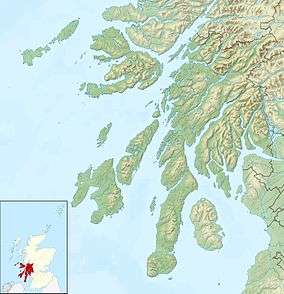Shuna, Slate Islands
Shuna (Gaelic Siuna) is one of the Slate Islands lying east of Luing on the west coast of Scotland.
| Gaelic name | Siùna |
|---|---|
| Meaning of name | Possibly sea island |
 The ruined castle | |
| Location | |
 Shuna Shuna shown within Argyll and Bute | |
| OS grid reference | NM760080 |
| Coordinates | 56.21°N 5.61°W |
| Physical geography | |
| Island group | Slate Islands |
| Area | 451 ha (1,114 acres) |
| Area rank | 74 [1] |
| Highest elevation | Druim na Dubh Ghlaic, 90 m (295 ft) |
| Administration | |
| Sovereign state | United Kingdom |
| Country | Scotland |
| Council area | Argyll and Bute |
| Demographics | |
| Population | 3[2] |
| Population rank | 80= [1] |
| Population density | 0.7/km2 (1.8/sq mi)[3] |
| References | [3][4][5] |
History
In 1815, James Yates, a Glasgow native living in Woodville in Devon, bought the island from Colonel McDonald of Lynedale.[6] In 1829 Yates bequeathed the island in trust to the magistrates and council of Glasgow, with profits from the estate divide two fifths to the city, two fifths to Glasgow University and one fifth to Glasgow Royal Infirmary.[6][7] This was disputed by Yates' heir, who accepted £300 from the trustees to settle his claim.[7] The revenue from the island was scarce and the trustees sold it in 1911.[8]
Shuna Castle was built as recently as 1911. It fell into disrepair in the 1980s when the cost of maintenance become too great.[9]
Unlike the other Slate Islands, Shuna has little slate, and has historically been farmed, although it is now overgrown with woodland. There are several cairns in the south and west of the small island.
During the nineteenth century the population numbered up to 69, but by the 2001 census, Shuna was one of four Scottish islands with a population of one.[10] The island has been privately owned by the Gully family since 1946. It is now occupied by a farmer and his family, who let four houses as holiday cottages and had a usually resident population of 3 in 2011.[2][9]
Wildlife
The island has healthy populations of red, roe and fallow deer; along with otters, common and grey seals, porpoises and dolphins out on the water.[9]
References
- Area and population ranks: there are c. 300 islands over 20 ha in extent and 93 permanently inhabited islands were listed in the 2011 census.
- National Records of Scotland (15 August 2013). "Appendix 2: Population and households on Scotland's Inhabited Islands" (PDF). Statistical Bulletin: 2011 Census: First Results on Population and Household Estimates for Scotland Release 1C (Part Two) (PDF) (Report). SG/2013/126. Retrieved 14 August 2020.
- Haswell-Smith, Hamish (2004). The Scottish Islands. Edinburgh: Canongate. ISBN 978-1-84195-454-7.
- Ordnance Survey. OS Maps Online (Map). 1:25,000. Leisure.
- Mac an Tàilleir, Iain (2003) Ainmean-àite/Placenames. (pdf) Pàrlamaid na h-Alba. Retrieved 26 August 2012.
- Session, Scotland. Court of (1832). "Yates's Trustees v Yeats &c.". Cases Decided in the Court of Session. Bell & Bradfute. pp. 565–571. Retrieved 4 November 2014.
- Municipal Corporations (Scotland) Commissioners (1835). "Report on the City of Glasgow; Branch VII: Shuna Trust". Report Vol. II. Command papers. W. Clowes and sons. pp. 20–21. Retrieved 4 November 2014.
- "The Last Years of the Old Regime". The History of Glasgow. electricscotland.com. pp. Volume 3 Chapter LI. Retrieved 4 November 2014.
- "Shuna Wildlife & History". Internet Archive. Original access: islandofshuna.co.uk on 28 July 2007. Archived at 14 August 2007. Retrieved 24 July 2012.
- General Register Office for Scotland (28 November 2003) Scotland's Census 2001 – Occasional Paper No 10: Statistics for Inhabited Islands. Retrieved 26 February 2012.

